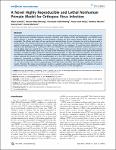A Novel Highly Reproducible and Lethal Nonhuman Primate Model for Orthopox Virus Infection
Kramski, Marit
Mätz-Rensing, Kerstin
Stahl-Hennig, Christiane
Kaup, Franz-Josef
Nitsche, Andreas
Pauli, Georg
Ellerbrok, Heinz
The intentional re-introduction of Variola virus (VARV), the agent of smallpox, into the human population is of great concern due its bio-terroristic potential. Moreover, zoonotic infections with Cowpox (CPXV) and Monkeypox virus (MPXV) cause severe diseases in humans. Smallpox vaccines presently available can have severe adverse effects that are no longer acceptable. The efficacy and safety of new vaccines and antiviral drugs for use in humans can only be demonstrated in animal models. The existing nonhuman primate models, using VARV and MPXV, need very high viral doses that have to be applied intravenously or intratracheally to induce a lethal infection in macaques. To overcome these drawbacks, the infectivity and pathogenicity of a particular CPXV was evaluated in the common marmoset (Callithrix jacchus). A CPXV named calpox virus was isolated from a lethal orthopox virus (OPV) outbreak in New World monkeys. We demonstrated that marmosets infected with calpox virus, not only via the intravenous but also the intranasal route, reproducibly develop symptoms resembling smallpox in humans. Infected animals died within 1–3 days after onset of symptoms, even when very low infectious viral doses of 56102 pfu were applied intranasally. Infectious virus was demonstrated in blood, saliva and all organs analyzed. We present the first characterization of a new OPV infection model inducing a disease in common marmosets comparable to smallpox in humans. Intranasal virus inoculation mimicking the natural route of smallpox infection led to reproducible infection. In vivo titration resulted in an MID50 (minimal monkey infectious dose 50%) of 8.36102 pfu of calpox virus which is approximately 10,000-fold lower than MPXV and VARV doses applied in the macaque models. Therefore, the calpox virus/marmoset model is a suitable nonhuman primate model for the validation of vaccines and antiviral drugs. Furthermore, this model can help study mechanisms of OPV pathogenesis.
No license information

